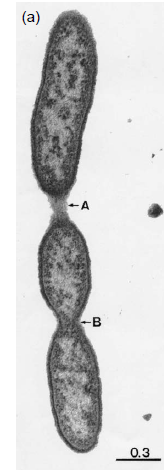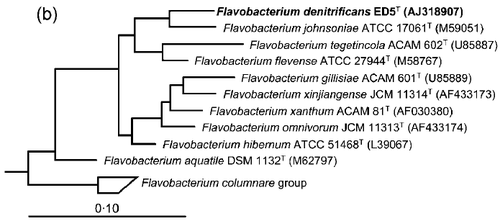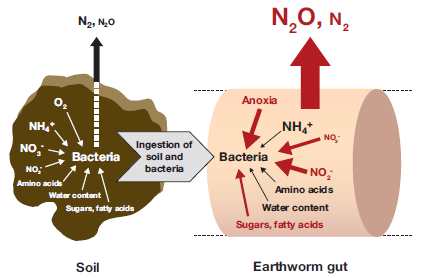Flavobacterium denitrificans
Classification
Bacteria; Bacteroidetes/Chlorobi group; Bacteroidetes; Flavobacteriia; Flavobacteriales; Flavobacteriaceae; Flavobacterium
Species
Flavobacterium denitrificans
Description and Significance
Flavobacterium denitrificans has flat, circular and yellow colonies. It is a facultative aerobe and an active member of the soil microbial community. It is activated in the earthworm (Aporrectodea caliginosa) gut, an anoxic and substrate rich habitat. Flavobacterium denitrificans carries out denitrificaiton, whish is the dissimilative reduction of nitrate and nitrite to dinitrogen. This process can also result in a significant production of nitrous oxide, a powerful greenhouse gas. Earthworms may account for more than 50% of the total nitrous oxide emitted form a soil they inhabit.
Genome Structure
The G+C content of Flavobacterium denitrificans 42.6 mol%. The 1Ss rRNA gene sequence was phylogenetically most closely related to the 16S rRNA gene sequences of Flavobacterium flevense and Flavobacterium johnsoniae (95% sequence similarities). It also clustered the 16S rRNA gene sequences of other type strains of the Cytophaga-Flavobacteia group. This shows the phylogeny of the genus Flavobacterium Is uncertain.
Cell Structure, Metabolism and Life Cycle
Flavobacterium denitrificans cells (0.8-3.0x0.3-0.9) are facultative, in chains from 3-14, rods, gram –negative, motile and sometimes contain connecting filaments. They form colonies that are flat, circular and yellow. Outer and cytoplasmic membranes were observed. Membranes contain c-type cytochromes, but b-type cytochromes may also occur. It is flexirubin reaction-, arginine dihydrolase- and catalase-positive and oxidase- and lysine decarboxylase negative.
Many sugars (as well as proteins) and other compounds (including proteins) can support it as electron donors. It utilizes arabinose, cellobiose, fructose, fumarate, gelatin, glucose, glutamate, inulin, lactose, maltose, mannitol, mannose, N-acetylglucosamine, pectin, starch, succinate and xylose as electron donors. 1-Butanol, 1-propanol, acetate, butyrate, chitin, citrate, ethanol, ethanolamine, glycerol, glycolate, i-butyrate, inositol, i-valerate, lactate, oxalate, propionate, raffinose, saccharose, sorbitol and tartrate do not supportive growth.
Oxygen, nitrate and nitrite are used as electron acceptors but not iron(III) and sulphate. Ammonium is used as a nitrogen source. Nitrous oxide is produced as a transient intermediate during the dissimilatory reduction of nitrate to dinitrogen.
Ecology and Pathogenesis
The earthworm Aporrectodea caliginosa gut contains soil derived nitrate and nitrite. This habitat is anoxic, moist, pH neutral, rich in proteins and carbohydrates derived from mucus and worm feed. This may serve as substrates for the ingested. Microorganisms, including Flavobacterium denitrificans, capable of anaerobiosis are selectively activated in the anoxic and substrate-rich environment. Earthworms supplement the ingested soil micoorganisms with mucopolysaccharides that activate microorganisms. The microorganisms than secrete exoenzymes that help the worm in digesting organic matter. This is called a mutualistic digestive system.
The earthworm gut emits the greenhouse gas nitrous oxide due to the activation of denitrification in their gut. Denitrifiers are more abundant in the gut in comparison to the soil. Concentrations of nitrous oxide in the earthworm alimentary channel are highest in the gut, indicating active dentrification.
This process of denitrification is a critical part of the nitrogen cycle. It is important to understand how different factors influence denitrification and how it is can be used to improve plant available nitrogen and reduce greenhouse gas emissions. In many soil ecosystems, nitrogen is the limiting nutrient for plant growth and it is continuously lost by denitrification (in addition to other processes). Nitrous oxide, lost through the process of denitrificaion, is among the six greenhouse gases included by the Kyoto protocol on climate change in 1997. Limiting it could help decrease the negative impact of agriculture on the environment.
References
Drake, Harold L., and Marcus A. Horn. "As the worm turns: the earthworm gut as a transient habitat for soil microbial biomes." Annu. Rev. Microbiol. 61 (2007): 169-189.
Horn, Marcus A., et al. "Dechloromonas denitrificans sp. nov., Flavobacterium denitrificans sp. nov., Paenibacillus anaericanus sp. nov. and Paenibacillus terrae strain MH72, N2O-producing bacteria isolated from the gut of the earthworm Aporrectodea caliginosa." International journal of systematic and evolutionary microbiology 55.3 (2005): 1255-1265.
Marcus A. Horn, Julian Ihssen, Carola Matthies, Pia K. Wüst, Peter Depkat-Jakob, Harold L. Drake. Microbial ecology of flavobacteria in soil – potential implications for greenhouse gas production: Flavobacterium denitrificans as transient inhabitant of the earthworm gut.
Philippot, Laurent, Sara Hallin, and Michael Schloter. "Ecology of denitrifying prokaryotes in agricultural soil." Advances in Agronomy 96 (2007): 249-305.
Author
Page authored by Kate Glanville & Di Liang, students of Microbial Ecology at Michigan State University.





